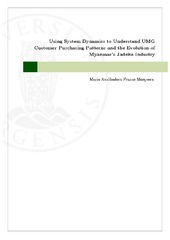| dc.description.abstract | This research draws on the system dynamics methodology to investigate, through a dynamic study of Myanmar's jadeite industry that goes from the year 2000 to 2022, the causes of fluctuating purchases of mining equipment at one of Myanmar's major distributors of heavy machinery. Supported by data from multiple online sources and interviews to two of Myanmar's major mining companies, a simulation model is developed to dynamically explain the behavior of the industry. It is hypothesized demand and supply loops, coupled with delays of various nature, act to cause instability and oscillations in Myanmar's jade mining industry and subsequently in the demand of mining equipment. Results from the model show that in the face of a mining rush" scenario, one in which the tendency of the government is to grant substantially more mining licenses than the base case, jade reserves are exhausted quickly and even get depleted within the simulation interval. In contrast, when less licenses than usual are granted, the market keeps requiring equipment for a longer time period, and the fact that reserves are not exhausted as quick, implies mineable land concessions and equipment purchases continue to take place, and that the sustainability or survival of UMG as a firm is not compromised as quick. However, in both scenarios ( base case" and mining rush") jade production peaks at different points in time to then follow an imminent collapsing trend. Furthermore, sensitivity analysis to the parameters (a) tons per acre, and (b) initial jade reserves show greater or lesser values do not alter the collapsing behavior of jade production and equipment purchases, but simply move sales and production curves to upper or lower boundaries. Finally, a structure for financial assessment is added to the model to show that in the face of a mining rush scenario," not favorable prices, and the due computation of a formal financial analysis, negative NPV results (from jade prices not being able to keep up with the vast amount of new machinery a boom in mining licenses requires) will deter license applications and will most likely be reflected into less purchases of equipment. This research is significantly relevant in that (a) it explains the fluctuations of equipment purchases dynamically, (b) results warn UMG about the imminent depletion of mineable land and with that the decay of its business, and (c) it sheds light on the research question, it explains the behavior of Myanmar's jade industry based on empirical data, something that has not been previously done. | en_US |
